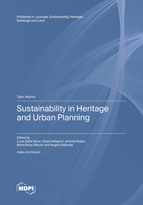Topic Menu
► Topic MenuTopic Editors



Sustainability in Heritage and Urban Planning

A printed edition is available here.
Topic Information
Dear Colleagues,
In the current international debate, real estate, cultural, and landscape assets represent a key element of the identity, uniqueness, and sustainable development of cities and regions.
It is also known that the quality of heritage is recognized as an advantage for urban and territorial regeneration, capable of bringing various multidimensional benefits (not only economic), since it can contribute to the identity of the territories and the cultural diversity of local communities, to the well-being and people’s health, as well as the creation of jobs, environmental and social regeneration, and the attractiveness of places.
However, activities related to the conservation and enhancement of heritage often require large investments, in the face of scarce resources and high investment uncertainties. To this end, it is increasingly necessary to identify and implement new urban and territorial development models and strategies to face the challenges of sustainable development, linked to the sustainable use of resources, based on research and innovation, a dynamic way to stimulate conservation, the development, renewal, and transmission to future generations of these essential resources for development. It is also important to consider how digital transformation affects these issues and leads to new visions and innovative approaches for sustainability. These approaches are increasingly based on the use of digital tools aimed at strengthening the participation, sharing of information, and, above all, making heritage inclusive and accessible to all.
Potential key research topics include applications that discuss (but are not limited to) the following:
- Appraisal and Evaluation: the role of adequate frameworks for evaluation and development of methodologies which, by addressing the complexity of the interests at stake, allow for evaluating the sustainability of programs and projects for the enhancement of heritage.
- Digital Transformation for Innovation and Information sharing: innovative models for the enhancement of heritage and facilitating the accessibility of information through digital tools, such as social networks, data visualization, and analysis platforms; augmented reality; the blockchain; the metaverse; and digital communication.
- The City Planning Tools and the Conservation, Redevelopment, and Enhancement of the Urban Landscape and its Cultural Heritage: What role and what relationship is there today between space planning and conservation? How have planning tools evolved to evaluate heritage and include digital transformation? What innovations are needed in planning to obtain enhancement processes?
Prof. Dr. Lucia Della Spina
Prof. Dr. Paola Pellegrini
Dr. Antonia Russo
Prof. Dr. Maria Rosa Valluzzi
Dr. Angela Viglianisi
Topic Editors
Keywords
- appraisal and evaluation: multi-dimensional evaluation, integrated assessment, integrated spatial assessment, adaptive decision-making process, circular economy principles, community-led processes, social innovation, innovative management, urban real estate values, investment risk;
- digital transformation for innovation and information sharing: digital transformation, information sharing, information accessibility, social networks, data analysis, artificial intelligence, virtual reality, blockchain, metaverse, digital communication, social media;
- conservation, redevelopment and enhancement of the urban landscape: built heritage, landscape conservation, priority of intervention, urban regeneration and valorization, urban heritage, densification and sustainability
Participating Journals
| Journal Name | Impact Factor | CiteScore | Launched Year | First Decision (median) | APC |
|---|---|---|---|---|---|

Sustainability
|
3.9 | 5.8 | 2009 | 18.8 Days | CHF 2400 |

Heritage
|
1.7 | 2.8 | 2018 | 16.9 Days | CHF 1600 |

Urban Science
|
2.0 | 4.5 | 2017 | 23.7 Days | CHF 1600 |

Buildings
|
3.8 | 3.1 | 2011 | 14.6 Days | CHF 2600 |

Land
|
3.9 | 3.7 | 2012 | 14.8 Days | CHF 2600 |

Information
|
3.1 | 5.8 | 2010 | 18 Days | CHF 1600 |

Applied Sciences
|
2.7 | 4.5 | 2011 | 16.9 Days | CHF 2400 |

MDPI Topics is cooperating with Preprints.org and has built a direct connection between MDPI journals and Preprints.org. Authors are encouraged to enjoy the benefits by posting a preprint at Preprints.org prior to publication:
- Immediately share your ideas ahead of publication and establish your research priority;
- Protect your idea from being stolen with this time-stamped preprint article;
- Enhance the exposure and impact of your research;
- Receive feedback from your peers in advance;
- Have it indexed in Web of Science (Preprint Citation Index), Google Scholar, Crossref, SHARE, PrePubMed, Scilit and Europe PMC.



